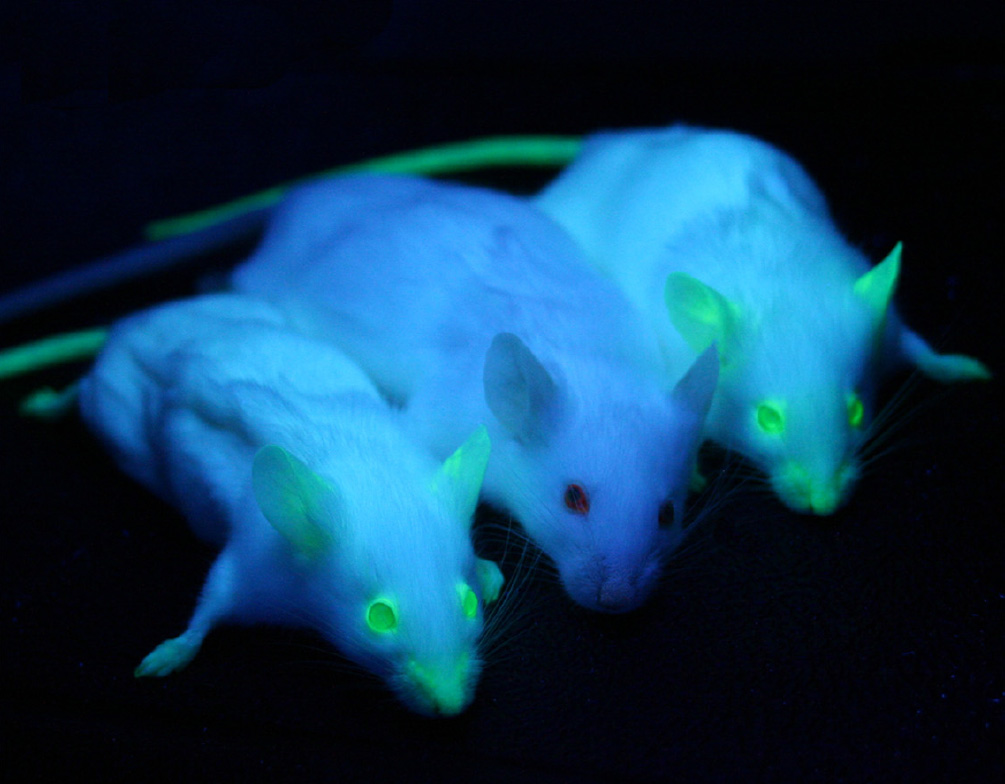You’re probably aware of the existence of transgenic animals, even if you haven’t heard the term before. Mice that glow in the dark? Transgenics. Silkworms spinning spider silk? Transgenics.
So, what is transgenics? Transgenics refers to the altering of the genome through the transfer of genes from one organism to another organism. The glow in the dark mice are expressing a gene for bioluminescence found in jellyfish, and the silkworms are using spider genes.
That’s all very well, but what’s the point in it? Do we really need glow in the dark mice? Glow in the dark mice make a cool example of the technology, but aren’t overly useful. The spider silk spinning silkworks are a lot more useful themselves. As you’ve probably heard, spiders silk is incredibly strong (comparable to steel), whilst being as flexible as rubber. The problem is that a single spider can’t produce very much, and harvesting the silk is a bit of an ordeal. A video of the process can be seen here:
Silkworms are much more efficient material producers, and so through these gene-spliced silk worms it is possible to reach much higher yields of spider silk.
The idea of using transgenic animals to make the best of both worlds has led to the development of the field known as farmaceuticals. This field involves splicing proteins which can be pharmacologically beneficial in to farm animals. These animals are perfectly healthy themselves, and can reproduce naturally, whilst still expressing this transgene. The term pharming may also be used, being born of the same portmanteau. It seems that pharming may refer to animal or plant hosts, whilst farmaceuticals is generally only applied to animals.
What sort of things can we do with farmaceuticals?
Milk production is a commonly targeted area for farmaceuticals. This is because it’s easy to collect from the animal, and non-destructive.
In 2009, the first drug to be produced in this way was granted approval by the US FDA; a drug called ATryn. ATryn is an anticoagulant antithrombin (a protein that stops blood clotting). It is harvested from the milk of goats which have been modified to produce human antithrombin through transgene insertion. One genetically modified goat can produce as much antithrombin in a year as is otherwise harvested in 90,000 blood donations.
Another milk-based example is Ruconest. Ruconest is a recombinant human C1 esterase inhibitor (specific protein inhibitor), designed to treat a disorder called Hereditary Angioedema (HAE). This disorder causes episodes of severe swelling, which can lead to death by asphyxiation if not treated. In this case the host animal to this modification is the rabbit, producing the protein inhibitor in its milk. As rabbits reproduce much more rapidly than larger animals, they are ideal for testing concepts. It is however recommended that people be tested for rabbit allergies prior to treatment.
Moving on to another easily harvestable vector, eggs. In 2015 the US FDA approved the creation of transgenic chickens to produce a drug known as Kanuma in their eggs. Kanuma contains recombinant human enzymes, and is used to treat Lysosomal Acid Lipase Deficiency (LAL-D), a metabolic disease which causes organ damage, often leading to premature death in infants. Prior to the development of this drug, there was no treatment available to sufferers. Kanuma has been shown to extend the lifespan of LAL-D suffers (raising the survival rate in newborns with a severe strain from a 0% chance of making it to one year old to 66%).
There are various other bits of work in the pipeline currently. Tilapia fish have been highlighted as lending themselves well to transgenic modification, and so may in the future be used in models. The potential for other genes to be transferred in to the eggs of chickens is also being examined, as is the milk of various animals including cows, goats, pigs, and rabbits. Blood has been found to not make a very good vector because it is unsuitable for storing large numbers of unstable recombinant proteins.
At this point, farmaceuticals is a field that’s in its early days; a lot of research is being undertaken, but little is ready for active production. In my mind it’s a really cool concept however, and is something that I’ll be keeping an eye on in the future.

Be First to Comment